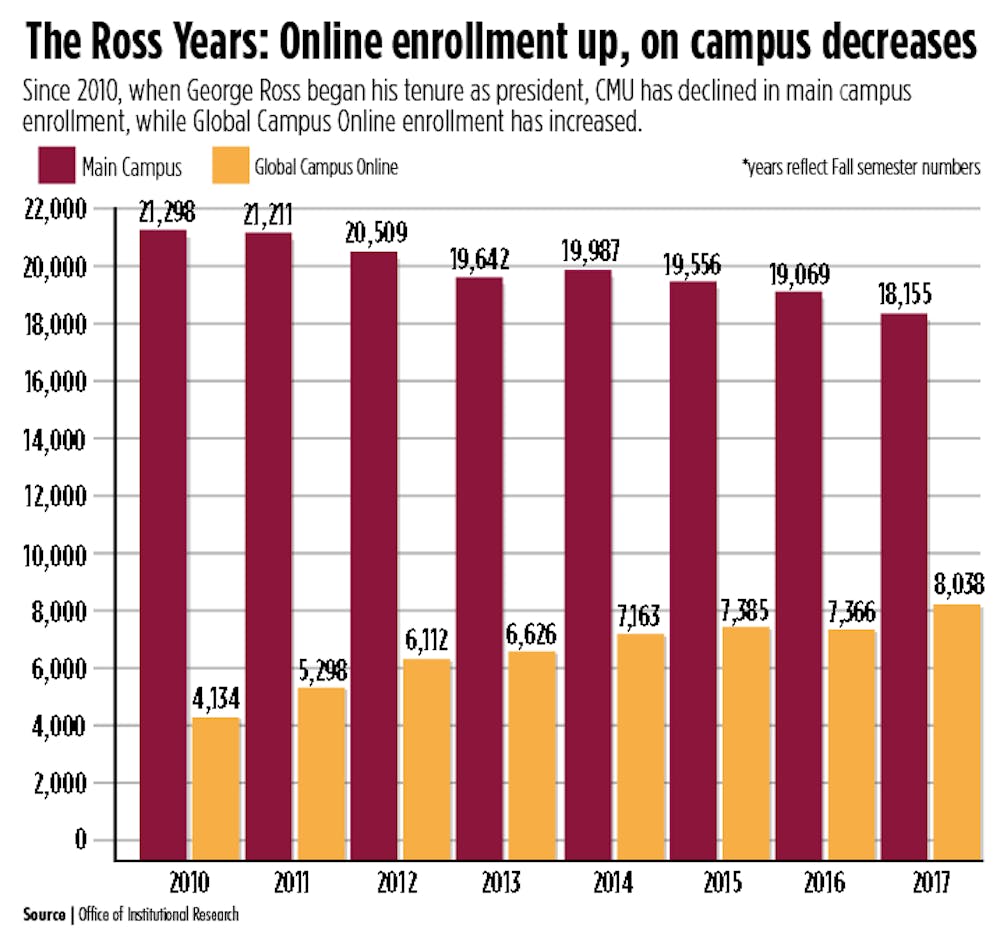Enrollment decline leads to focus on recruiting efforts
Steven Johnson is not pleased with Central Michigan University’s Fall 2017 enrollment number.
The 2018-2022 Strategic Enrollment Management Plan that Johnson and his division have drafted is designed to recruit prospective students and retain them until graduation.
Johnson, CMU’s vice president of Enrollment and Student Services, said Michigan’s decreasing high school population is one reason enrollment dropped to 23,335, or about 4 percent fewer students compared to Fall 2016. The university usually attracts about 3-3.4 percent of Michigan’s high school graduates, Johnson said. This fall, CMU recruited only 3 percent of those graduates compared to last year’s 3.1 percent.
“We always want more (and) better but (President George Ross) has been very conscious to making sure we don’t compromise quality,” Johnson said.
The high school grade point average for this year’s incoming freshmen class was 3.36, with an average SAT score of 1,104.6.
“We pay particular attention (to) the credentials of the incoming class — making sure those don’t drop before we look at the total number of students that are available,” Johnson said.
Undergraduate enrollment dropped to 17,845 from 18,769 in Fall 2016, according to the Office of Institutional Research. CMU also recruited 3,076 freshmen (First Time in Any College) and 1,121 transfer students compared to 3,487 and 1,381, respectively, in Fall 2016. Minority enrollment stayed at about 22 percent, or about the same as last year.
In Fall 2010, when Ross began his tenure as president, CMU’s main campus enrollment was 21,298. Main campus enrollment has declined every year since Fall 2010 except for Fall 2014. That year, 19,897 students were enrolled on Main Campus compared to 19,642 in Fall 2013.
The university continues to invest heavily in retention efforts, Johnson said. Fall semester’s one-year retention rate dropped to 76.5 percent from 77.3 in Fall 2016. The fall two-year retention rate dropped to 69.2 percent from 71.5 percent in Fall 2016.
“We have to make sure students are successful while they’re here,” he said.
Global Campus Online enrollment was 8,038 – nearly 5,000 more students than 2008. When the university released its enrollment numbers Jan. 30 it highlighted the growth in online courses from Fall 2016 to Fall 2017 – a 9 percent jump that is the largest one-year increase in the program’s history.
“We fully embrace (online) as one of the options for delivering a quality education,” Johnson said.
CMU is in a hyper-competitive environment with other universities to compete for fewer students in Michigan, Johnson said. The university owning its identity and allowing graduates to tell their stories makes it attractive to prospective students, he added.
“Every institution in Michigan is facing some challenges, but the challenges present opportunities,” Johnson said.
Breaking with its traditional practice, CMU elected to release its Fall enrollment numbers in January after the completion of the semester to comply with its new count date policy, which was voted on by the board of trustees in June. Multiple start dates for classes in Global Campus led to the change, Johnson said.
“We are still recruiting new undergraduate students throughout the fall semester that historically have not been referenced because we were rushing to put out the enrollment number,” Johnson said.
In the past, CMU used the previous Fall Global Campus enrollment figure with its current semester total. The shift was made by the board to be more accurate and reflect the shifts that were occurring between students and demographics.
“The number we report now is far more accurate,” said Vice President of Finance and Administrative Services Barrie Wilkes.
When Global Campus started in the 1970s, it was primarily used by graduate students taking advanced classes. In the last decade, that changed. Today about 50 percent of the students taking online classes are undergraduates pursuing bachelor degrees.
“We are the right fit for most students,” Johnson said. “What causes me concern is that there’s just fewer people out there.”
CMU not only has its challenges nationally, but has cited immigration policy in Washington, D.C. as a reason for international enrollment concerns. International enrollment fell to fewer than 1,000 students for the first time since 2013 – dropping to 927 students compared to 1,230 in Fall 2016. International recruitment, Johnson said, is “very volatile.”
“We’re not welcome in every country. More countries are starting to deliver their own forms of education,” Johnson said. “That was not any part of the equation 10-20 years ago. We are constantly having to think differently around international. We are far more restricted in how nimble and organic you can be, whereas we have more opportunities in the U.S.”







